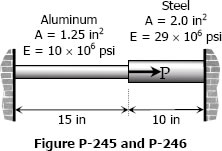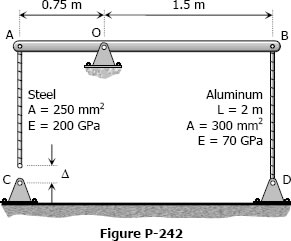Solution to Problem 246 Statically Indeterminate
Problem 246
Referring to the composite bar in Problem 245, what maximum axial load P can be applied if the allowable stresses are 10 ksi for aluminum and 18 ksi for steel.
 MATHalinoEngineering Math Review
MATHalinoEngineering Math ReviewProblem 246
Referring to the composite bar in Problem 245, what maximum axial load P can be applied if the allowable stresses are 10 ksi for aluminum and 18 ksi for steel.
Problem 245
The composite bar in Fig. P-245 is firmly attached to unyielding supports. Compute the stress in each material caused by the application of the axial load P = 50 kips.

Problem 244
A homogeneous bar with a cross sectional area of 500 mm2 is attached to rigid supports. It carries the axial loads P1 = 25 kN and P2 = 50 kN, applied as shown in Fig. P-244. Determine the stress in segment BC. (Hint: Use the results of Prob. 243, and compute the reactions caused by P1 and P2 acting separately. Then use the principle of superposition to compute the reactions when both loads are applied.)

Problem 243
A homogeneous rod of constant cross section is attached to unyielding supports. It carries an axial load P applied as shown in Fig. P-243. Prove that the reactions are given by R1 = Pb/L and R2 = Pa/L.

Problem 242
The assembly in Fig. P-242 consists of a light rigid bar AB, pinned at O, that is attached to the steel and aluminum rods. In the position shown, bar AB is horizontal and there is a gap, Δ = 5 mm, between the lower end of the steel rod and its pin support at C. Compute the stress in the aluminum rod when the lower end of the steel rod is attached to its support.

Problem 241
 As shown in Fig. P-241, three steel wires, each 0.05 in.2 in area, are used to lift a load W = 1500 lb. Their unstressed lengths are 74.98 ft, 74.99 ft, and 75.00 ft.
As shown in Fig. P-241, three steel wires, each 0.05 in.2 in area, are used to lift a load W = 1500 lb. Their unstressed lengths are 74.98 ft, 74.99 ft, and 75.00 ft.
(a) What stress exists in the longest wire?
(b) Determine the stress in the shortest wire if W = 500 lb.
Problem 240
Three steel eye-bars, each 4 in. by 1 in. in section, are to be assembled by driving rigid 7/8-in.-diameter drift pins through holes drilled in the ends of the bars. The center-line spacing between the holes is 30 ft in the two outer bars, but 0.045 in. shorter in the middle bar. Find the shearing stress developed in the drip pins. Neglect local deformation at the holes.
Problem 239
The rigid platform in Fig. P-239 has negligible mass and rests on two steel bars, each 250.00 mm long. The center bar is aluminum and 249.90 mm long. Compute the stress in the aluminum bar after the center load P = 400 kN has been applied. For each steel bar, the area is 1200 mm2 and E = 200 GPa. For the aluminum bar, the area is 2400 mm2 and E = 70 GPa.

Problem 238
The lower ends of the three bars in Fig. P-238 are at the same level before the uniform rigid block weighing 40 kips is attached. Each steel bar has a length of 3 ft, and area of 1.0 in.2, and E = 29 × 106 psi. For the bronze bar, the area is 1.5 in.2 and E = 12 × 106 psi. Determine (a) the length of the bronze bar so that the load on each steel bar is twice the load on the bronze bar, and (b) the length of the bronze that will make the steel stress twice the bronze stress.

Problem 235
A timber column, 8 in. × 8 in. in cross section, is reinforced on each side by a steel plate 8 in. wide and t in. thick. Determine the thickness t so that the column will support an axial load of 300 kips without exceeding a maximum timber stress of 1200 psi or a maximum steel stress of 20 ksi. The moduli of elasticity are 1.5 × 106 psi for timber, and 29 × 106 psi for steel.